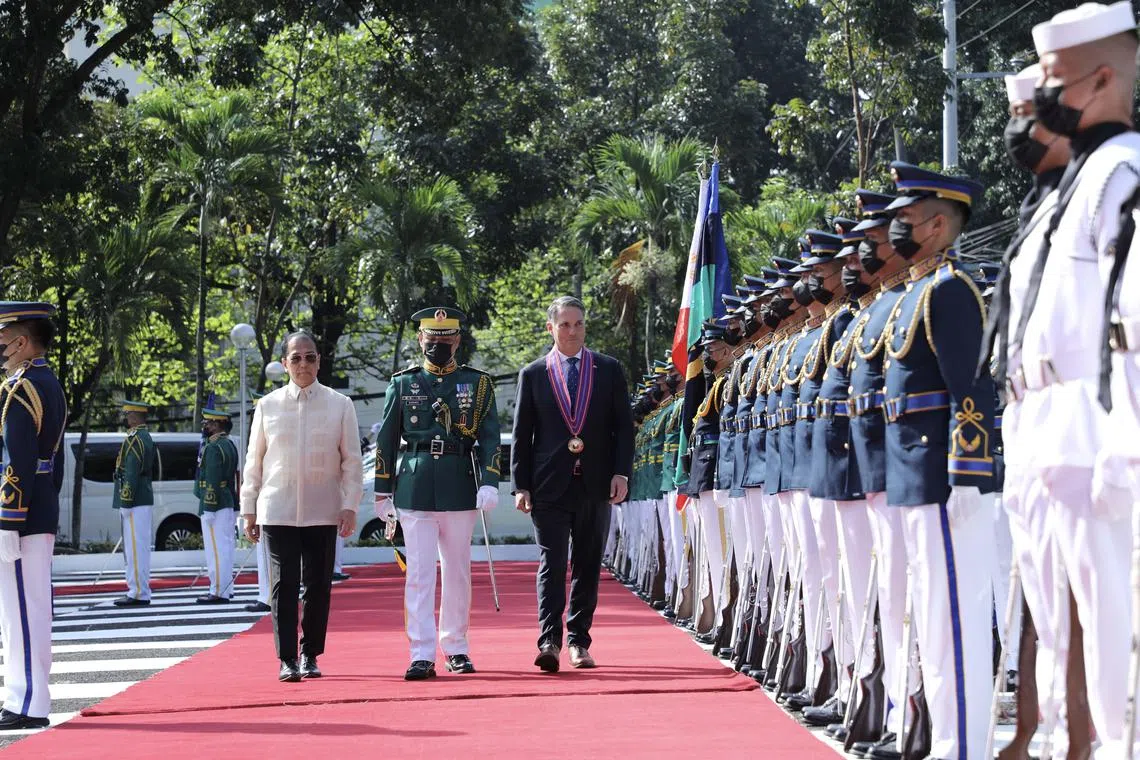Philippines, Australia eye joint patrols in South China Sea as tensions rise
Sign up now: Get insights on Asia's fast-moving developments

(From left) Philippines Defense Secretary Carlito Galvez, Australian Deputy Prime Minister and Minister of Defense Richard Marles walking past military honor guards during arrival honors at the DND compound in Quezon City, Metro Manila, on Feb 22, 2023.
PHOTO: DEPARTMENT OF NATIONAL DEFENSE
Follow topic:
MANILA - The Philippines and Australia are exploring joint maritime patrols in the South China Sea amid Beijing’s increasing military actions in the disputed waters.
Australian Defence Minster Richard Marles said he discussed the joint patrols with his Filipino counterpart Carlito Galvez Jr during his visit to Manila on Wednesday.
“As countries which are committed to the global rules-based order, it is natural that we should think about ways in which we can cooperate in this respect,” said Mr Marles, who is also Deputy Prime Minister.
“And so we did talk today about the possibility of exploring joint patrols, and we will continue that work, and we hope that that comes to fruition soon.”
Mr Marles also met Philippine President Ferdinand Marcos Jr and other senior government officials on Wednesday, and will travel to Thailand later this week.
The talks on potential joint patrols in the South China Sea followed similar discussions between the Philippines and the United States.
The Philippines is a military ally of Australia and the US, and all three are bolstering security ties to push for a free and open Indo-Pacific against China’s growing influence in the region.
Mr Marles said Australia considers the Philippines a “very central” party to his country’s interests in the Indo-Pacific.
The Philippines’ location makes it a crucial security and economic partner for Australia, should tensions flare over the South China Sea dispute and the China-Taiwan conflict.
“We’re both countries who are deeply invested in asserting the United Nations Convention on the Law of the Sea throughout the world, in places like the South China Sea where most of Australia’s trade traverses,” said Mr Marles.
China claims almost the entire South China Sea, through which trillions of dollars in trade pass annually. The other claimants are the Philippines, Brunei, Malaysia, Vietnam and Taiwan.
Should the plan by Australia and the Philippines be pushed through, it would not be the first time the two countries will be holding joint maritime patrols.
Mr Galvez noted that their joint patrols in the Celebes and Sulu seas off the coast of southern Philippines in 2017 paved the way for deeper defence cooperation with Indonesia and Malaysia. The seas had been fraught with kidnapping and hijacking attacks by Abu Sayyaf terrorists.
Military deals between the Philippines and Australia over the years have allowed the holding of joint military exercises, as well as high-level visits and dialogues between officials.
Since 2015, Canberra has donated at least five landing craft vessels
Mr Galvez also thanked Australia for consistently backing a 2016 international tribunal ruling that said the eastern parts of the South China Sea that fall within Manila’s 200-nautical mile exclusive economic zone belong to the Philippines. Filipinos call this area the West Philippine Sea.
China has refused to recognise the ruling.
Beijing has instead ramped up its military and island-building activities in the South China Sea, with Manila filing multiple diplomatic protests due to Chinese harassment of Filipino vessels and fishermen.
Earlier in February, a Chinese Coast Guard vessel aimed a military-grade laser at a Philippine Coast Guard ship. Nations like Australia and the US supported the Philippines in the laser dispute with China.


